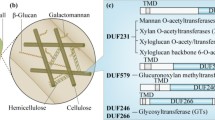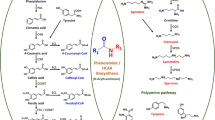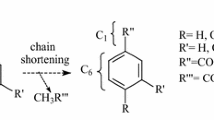Abstract
Main conclusion
Two distinct cinnamoyl-coenzyme A reductases (CCRs) from Selaginella moellendorffii were evaluated, and of these, SmCCR2-1, which has both distinct sequence motifs and catalytic properties, was clustered into a new CCR subgroup.
Cinnamoyl-coenzyme A reductases (CCRs) have been reported in many land plants to have critical functions in monolignol biosynthesis. In this study, we performed a genome-wide screen and obtained two distinct SmCCRs from S. moellendorffii. Phylogenetic analysis indicated that SmCCR2 (both SmCCR2-1 and 2-2) and SmCCR3 together with PpaCCR belong to a distinct subgroup of genuine CCRs with variations in the NAD(P)H-binding motif. Enzymatic assays showed detectable activity by both SmCCR1 and SmCCR2-1 toward four hydroxycinnamoyl-CoA esters. SmCCR1, which clustered with reported CCRs from angiosperms and gymnosperms, exhibited specificity toward feruloyl-CoA, while SmCCR2-1 showed a preference for sinapoyl-CoA. Interestingly, the reaction temperature profiles for SmCCR1 and SmCCR2-1 are complementary. Homology models and molecular simulations suggest that the variations in NADPH-binding motifs, especially R(X)6K instead of R(X)5K, affect the NADP+ conformation. Notably, the signature motif NWYCY was replaced with NGYCL in SmCCR1 and with EWYCL in SmCCR2-1, while the signature residues H202 and R253, reported in a previous study, were conserved in SmCCR1 and SmCCR2-1 but varied in SmCCR-like genes. It is likely that NWYCY is not a reliable signature for CCRs in plants. The detectable activity of site-direct mutant S123T of SmCCR1 suggested that S123 which consists of catalytic triad is changeable. Possible evolution process for the emergence of two subgroups of genuine CCRs was also revealed. Altogether, these findings revise our understanding of CCRs with regard to divergence and active sites.





Similar content being viewed by others
References
Baltas M, Lapeyre C, Bedos-Belval F, Maturano M, Saint-Aguet P, Roussel L, Duran H, Grima-Pettenati J (2005) Kinetic and inhibition studies of cinnamoyl-CoA reductase 1 from Arabidopsis thaliana. Plant Physiol Biochem 43:746–753
Bhuiyan NH, Selvaraj G, Wei Y, King J (2009) Role of lignification in plant defense. Plant Signal Behav 4:158–159
Boerjan W, Ralph J, Baucher M (2003) Lignin biosynthesis. Annu Rev Plant Biol 54:519–546
Carugo O, Argos P (1997) NADP-dependent enzymes. I: conserved stereochemistry of cofactor binding. Proteins Struct Funct Bioinform 28:10–28
Chao N, Liu S-X, Liu B-M, Li N, Jiang X-N, Gai Y (2014) Molecular cloning and functional analysis of nine cinnamyl alcohol dehydrogenase family members in Populus tomentosa. Planta 240:1097–1112
Chao N, Ning L, Qi Q, Shuang L, Tong L, Jiang XN, Ying G (2016) Characterization of the cinnamoyl-CoA reductase (CCR) gene family in Populus tomentosa reveals the enzymatic active sites and evolution of CCR. Planta 245:61–75
Dyrløv Bendtsen J, Nielsen H, von Heijne G, Brunak S (2004) Improved prediction of signal peptides: SignalP 3.0. J Mol Biol 340:783–795
Escamilla-Treviño LL, Shen H, Uppalapati SR, Ray T, Tang Y, Hernandez T, Yin Y, Xu Y, Dixon RA (2010) Switchgrass (Panicum virgatum) possesses a divergent family of cinnamoyl CoA reductases with distinct biochemical properties. New Phytol 185:143–155
Filling C, Berndt KD, Benach J, Knapp S, Prozorovski T, Nordling E, Ladenstein R, Jörnvall H, Oppermann U (2002) Critical residues for structure and catalysis in short-chain dehydrogenases/reductases. J Biol Chem 277:25677–25684
Goffner D, Campbell MM, Campargue C, Clastre M, Borderies G, Boudet A, Boudet AM (1994) Purification and characterization of cinnamoyl-coenzyme A: NADP oxidoreductase in Eucalyptus gunnii. Plant Physiol 106:625–632
Huang L, Schiefelbein J (2015) Conserved gene expression programs in developing roots from diverse plants. Plant Cell 27:2119–2132
Joernvall H, Persson B, Krook M, Atrian S, Gonzalez-Duarte R, Jeffery J, Ghosh D (1995) Short-chain dehydrogenases/reductases (SDR). Biochemistry 34:6003–6013
Labeeuw L, Martone PT, Boucher Y, Case RJ (2015) Ancient origin of the biosynthesis of lignin precursors. Biol Direct 10:23
Larsen K (2004) Molecular cloning and characterization of cDNAs encoding cinnamoyl CoA reductase (CCR) from barley (Hordeum vulgare) and potato (Solanum tuberosum). J Plant Physiol 161:105–112
Lauvergeat V, Lacomme C, Lacombe E, Lasserre E, Roby D, Grima-Pettenati J (2001) Two cinnamoyl-CoA reductase (CCR) genes from Arabidopsis thaliana are differentially expressed during development and in response to infection with pathogenic bacteria. Phytochemistry 57:1187–1195
Lüderitz T, Grisebach H (1981) Enzymic synthesis of lignin precursors comparison of cinnamoyl-CoA reductase and cinnamyl alcohol: NADP + dehydrogenase from spruce (Picea abies L.) and soybean (Glycine max L.). Eur J Biochem 119:115–124
Ma Q-H (2007) Characterization of a cinnamoyl-CoA reductase that is associated with stem development in wheat. J Exp Bot 58:2011–2021
Ma Q-H, Tian B (2005) Biochemical characterization of a cinnamoyl-CoA reductase from wheat. Biol Chem 386:553–560
Oppermann UC, Persson B, Filling C, Jörnvall H (1996) Structure-function relationships of SDR hydroxysteroid dehydrogenases. Enzymology and molecular biology of carbonyl metabolism, vol 6. Springer, Berlin, pp 403–415
Pan H, Zhou R, Louie GV, Mühlemann JK, Bomati EK, Bowman ME, Dudareva N, Dixon RA, Noel JP, Wang X (2014) Structural studies of cinnamoyl-CoA reductase and cinnamyl-alcohol dehydrogenase, key enzymes of monolignol biosynthesis. Plant Cell 26:3709–3727
Sarni F, Grand C, Boudet AM (1984) Purification and properties of cinnamoyl-CoA reductase and cinnamyl alcohol dehydrogenase from poplar stems (Populus × euramericana). Eur J Biochem 139:259–265
Sonawane P, Patel K, Vishwakarma RK, Srivastava S, Singh S, Gaikwad S, Khan BM (2013) Probing the active site of cinnamoyl CoA reductase 1 (Ll-CCRH1) from Leucaena leucocephala. Int J Biol Macromol 60:33–38
Stöekigt J, Zenk M (1975) Chemical syntheses and properties of hydroxycinnamoyl-coenzyme A derivatives. Zeitschrift für Naturforschung C 30:352–358
Tamura K, Peterson D, Peterson N, Stecher G, Nei M, Kumar S (2011) MEGA5: molecular evolutionary genetics analysis using maximum likelihood, evolutionary distance, and maximum parsimony methods. Mol Biol Evol 28:2731–2739
Vanholme R, Demedts B, Morreel K, Ralph J, Boerjan W (2010) Lignin biosynthesis and structure. Plant Physiol 153:895–905
Weng JK, Chapple C (2010) The origin and evolution of lignin biosynthesis. New Phytol 187:273–285
Weng JK, Banks JA, Chapple C (2008) Parallels in lignin biosynthesis: a study in Selaginella moellendorffii reveals convergence across 400 million years of evolution. Commun Integr Biol 1:20–22
Weng JK, Akiyama T, Bonawitz ND, Li X, Ralph J, Chapple C (2010) Convergent evolution of syringyl lignin biosynthesis via distinct pathways in the lycophyte Selaginella and flowering plants. Plant Cell 22:1033–1045
Weng JK, Akiyama T, Ralph J, Chapple C (2011) Independent recruitment of an O-methyltransferase for syringyl lignin biosynthesis in Selaginella moellendorffii. Plant Cell 23:2708–2724
Zemach A, Mcdaniel IE, Silva P, Zilberman D (2010) Genome-wide evolutionary analysis of eukaryotic DNA methylation. Science 328:916–919
Zhou R, Jackson L, Shadle G, Nakashima J, Temple S, Chen F, Dixon RA (2010) Distinct cinnamoyl CoA reductases involved in parallel routes to lignin in Medicago truncatula. Proc Natl Acad Sci 107:17803–17808
Acknowledgements
This work was jointly supported by the Fundamental Research Funds for the Central Universities (BLYJ201504 to N.C.), National Natural Science Foundation (NSF 31300498 to Y.G.), High Technology Research and Development 863 Program (2011AA100203 to X. N. Jiang), (Grant Numbers J1103516, J1310005, ITR 13047) the Basic Science Basement Facility Buildup and Talent Training Program Project from National Natural Science Foundation of China (NSFC) and PCSIRT.
Author information
Authors and Affiliations
Corresponding author
Electronic supplementary material
Below is the link to the electronic supplementary material.
425_2017_2678_MOESM3_ESM.tif
Online Resource 3 Expression profile of SmCCR and SmCCR-like genes in underground and aerial tissues. The left heatmap showed the expression profile of SmCCR and its homologs in root meristematic (MZ) and mixed elongation and differentiation (EDZ) zones with RPKM values and the right bars indicated the expression profile in aerial tissues of Selaginella moellendorffii (TIFF 774 kb)
425_2017_2678_MOESM4_ESM.tif
Online Resource 4 qRT-PCR analysis of transcript abundance of SmCCR1 and SmCCR2-1 in plants with different temperature treatment. Error bars represent STDEV of biological triplicates (TIFF 9871 kb)
Rights and permissions
About this article
Cite this article
Chao, N., Li, S., Li, N. et al. Two distinct cinnamoyl-CoA reductases in Selaginella moellendorffii offer insight into the divergence of CCRs in plants. Planta 246, 33–43 (2017). https://doi.org/10.1007/s00425-017-2678-8
Received:
Accepted:
Published:
Issue Date:
DOI: https://doi.org/10.1007/s00425-017-2678-8




